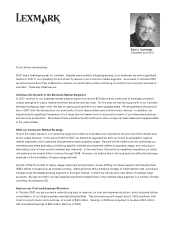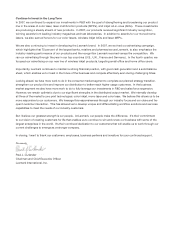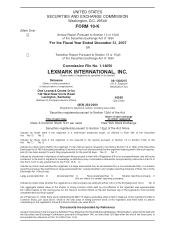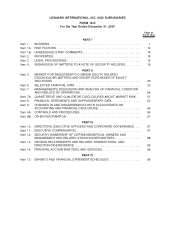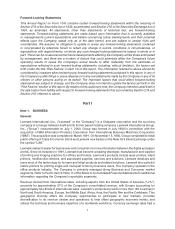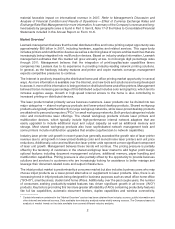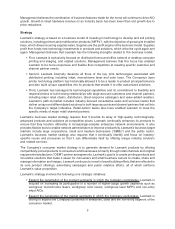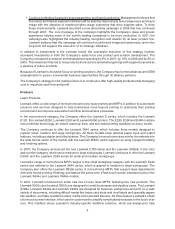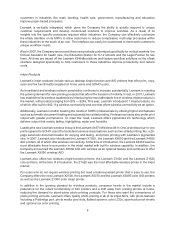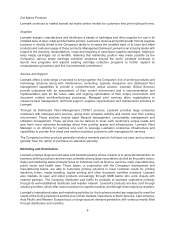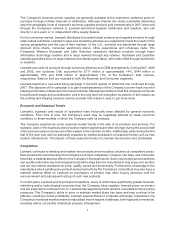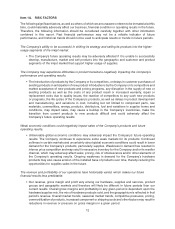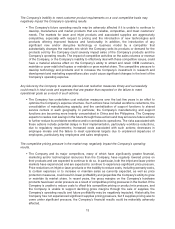Lexmark 2007 Annual Report Download - page 13
Download and view the complete annual report
Please find page 13 of the 2007 Lexmark annual report below. You can navigate through the pages in the report by either clicking on the pages listed below, or by using the keyword search tool below to find specific information within the annual report.The Company’s business printer supplies are generally available at the customer’s preferred point-of-
purchase through multiple channels of distribution. Although channel mix varies somewhat depending
upon the geography, most of Lexmark’s business supplies products sold commercially in 2007 were sold
through the Company’s network of Lexmark-authorized supplies distributors and resellers, who sell
directly to end-users or to independent office supply dealers.
For the consumer market, Lexmark distributes its branded inkjet products and supplies primarily through
retail outlets worldwide. Lexmark’s sales and marketing activities are organized to meet the needs of the
various geographies and the size of their markets. In the U.S., products are distributed through large
discount store chains, consumer electronics stores, office superstores and wholesale clubs. The
Company’s Western European and Latin American operations distribute products through major
information technology resellers and in large markets through key retailers. Australian and Canadian
marketing activities focus on large retail account demand generation, with orders filled through distributors
or resellers.
Lexmark also sells its products through numerous alliances and OEM arrangements. During 2007, 2006
and 2005, one customer, Dell, accounted for $717 million or approximately 14%, $744 million or
approximately 15% and $782 million or approximately 15% of the Company’s total revenue,
respectively. Sales to Dell are included in both the Business and Consumer segments.
Lexmark launched a new advertising campaign in the third quarter of 2006 that has continued through
2007. The objective of the campaign is to gain broad awareness of the Company’s proven track record of
helping world-class companies to be more productive. Management believes that this campaign continues
to build brand image and consideration, and in the long term will strengthen its position in the industry as
the printing and imaging solutions service provider that makes it easy to get more done.
Economic and Seasonal Trends
Lexmark’s business and results of operations have historically been affected by general economic
conditions. From time to time, the Company’s sales may be negatively affected by weak economic
conditions in those markets in which the Company sells its products.
The Company experiences some seasonal market trends in the sale of its products and services. For
example, sales in the business and consumer market segments are often stronger during the second half
of the year and sales in Europe are often weaker in the summer months. Additionally, sales during the first
half of the year may also be adversely impacted by market anticipation of seasonal trends such as new
product introductions. The impact of these seasonal trends on Lexmark has become less predictable.
Competition
Lexmark continues to develop and market new products and innovative solutions at competitive prices.
New product announcements by the Company’s principal competitors, however, can have, and in the past,
have had, a material adverse effect on the Company’s financial results. Such new product announcements
can quickly undermine any technological competitive edge that one manufacturer may enjoy over another
and set new market standards for price, quality, speed and functionality. Furthermore, knowledge in the
marketplace about pending new product announcements by the Company’s competitors may also have a
material adverse effect on Lexmark as purchasers of printers may defer buying decisions until the
announcement and subsequent testing of such new products.
In recent years, Lexmark and its principal competitors, many of which have significantly greater financial,
marketing and/or technological resources than the Company, have regularly lowered prices on printers
and are expected to continue to do so. Lexmark has experienced and remains vulnerable to these pricing
pressures. The Company’s ability to grow or maintain market share has been and may continue to be
affected, resulting in lower profitability. Lexmark expects that as it competes with larger competitors, the
Company’s increased market presence may attract more frequent challenges, both legal and commercial,
including claims of possible intellectual property infringement.
7


